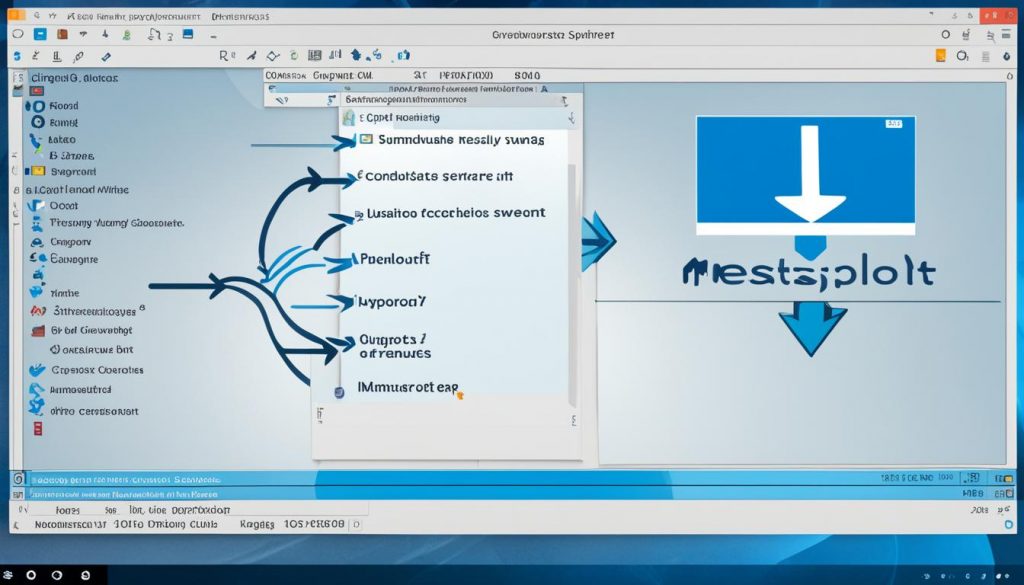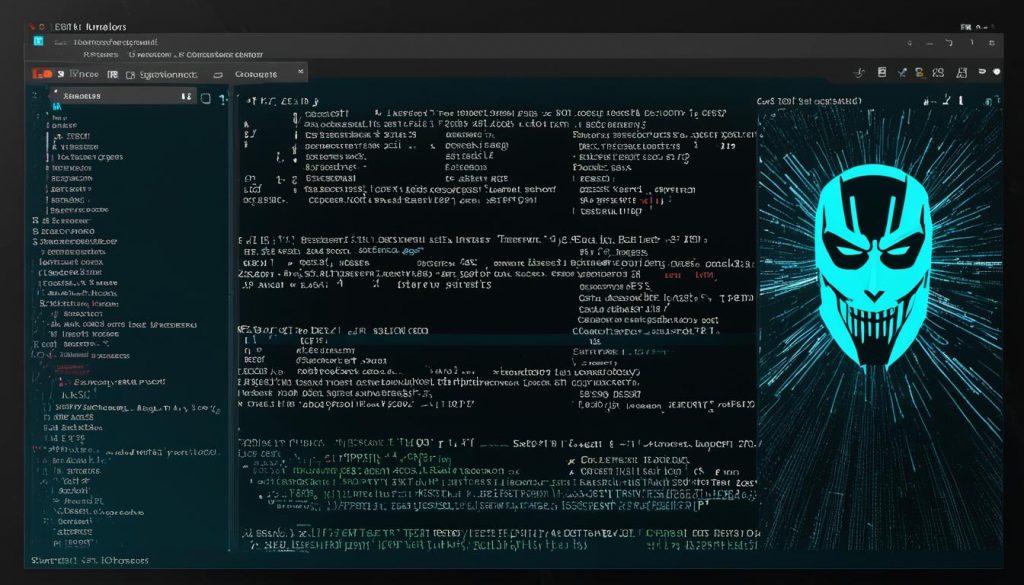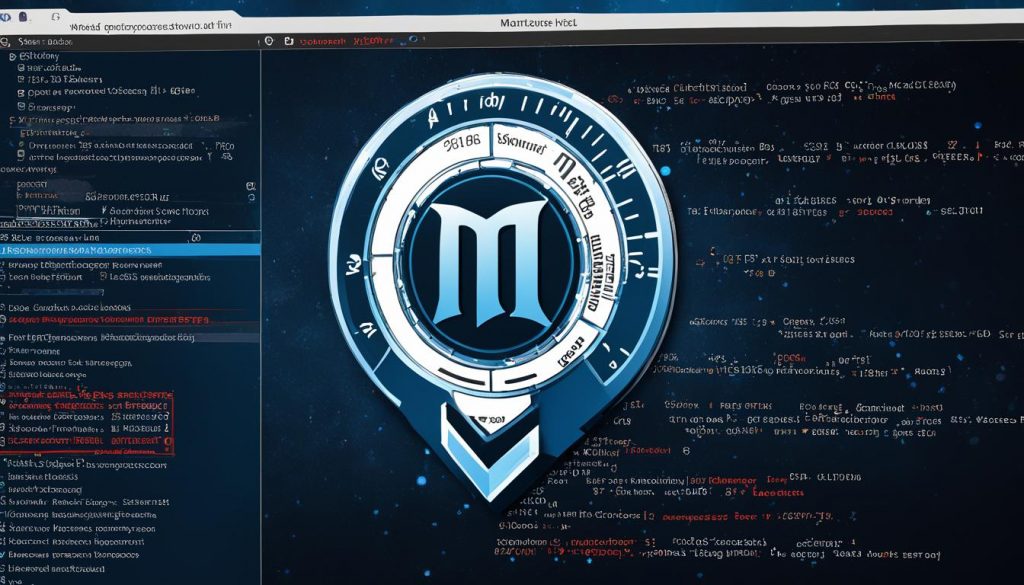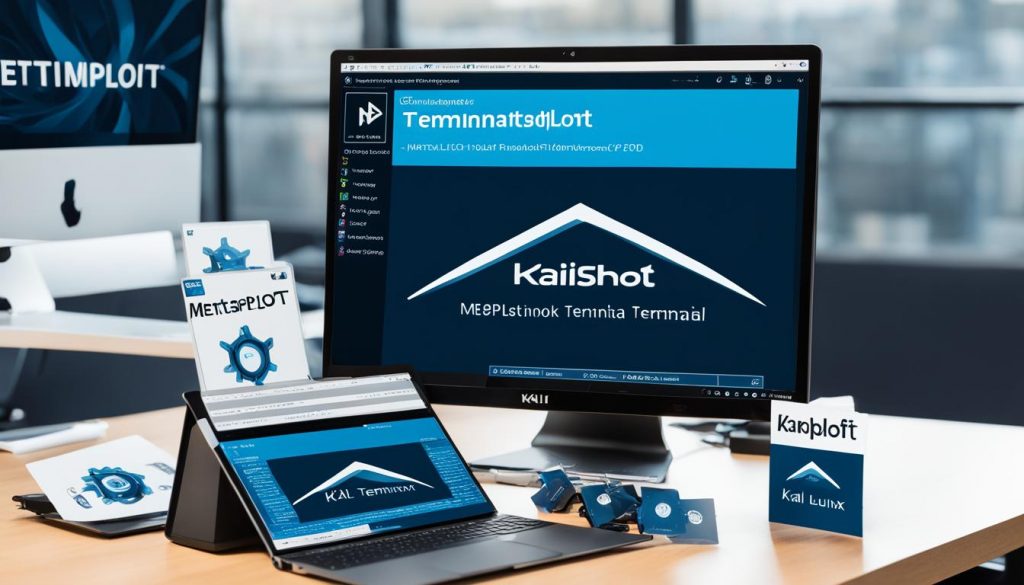How to update metasploit in kali linux The Metasploit Framework, developed by Rapid7, is a crucial tool for penetration testing, included with Kali Linux. It’s vital to understand how to update Metasploit to maintain its effectiveness. Regular updates are key to ensuring the platform remains a powerful tool for cybersecurity. They bring new features like an expanded vulnerability database, enhanced exploit tools, and integrated payloads.
By keeping Metasploit updated, I can utilize the latest exploits and tools. This boosts my ability to conduct thorough penetration tests. Thus, it’s essential for anyone involved in cybersecurity to stay current with these updates.
Yet, finding Metasploit updates can be challenging, as they’re not always in the standard Kali Linux repositories. I might encounter issues like access restrictions or dependencies that complicate the update process. This guide aims to simplify the process of updating Metasploit, covering various repositories and methods for a smooth update.
How to update metasploit in kali linux
Table of Contents
Key Takeaways
- Metasploit Framework is essential for penetration testing and is included with Kali Linux.
- Regular updates to Metasploit enhance security features and exploit capabilities.
- Accessing the Metasploit repository directly can provide the latest versions and features.
- Common update problems may include firewall issues and missing dependencies.
- Both command line and GUI options are available for conducting updates in Metasploit.
Introduction to Metasploit Framework
The Metasploit Framework is a vital tool in the realm of penetration testing. Developed by Rapid7, it stands out as an open-source platform for ethical hackers and security experts. Its key strength lies in its vast library of exploits and payloads, aimed at uncovering vulnerabilities across different systems.
To run the Metasploit Framework, a machine must meet certain specifications. It needs a processor with a 2 GHz speed, 4GB of RAM (ideally 8GB), and at least 1GB of disk space. For the best performance, having 50GB of disk space is recommended. In contrast, Kali Linux can function adequately with just 128MB of RAM and 2GB of disk space, showcasing its efficiency and versatility.
With Metasploit, I can scan networks for vulnerabilities and test these weaknesses using pre-defined exploits. The framework organizes its modules into three primary categories: Auxiliary, Exploits, and Post. Each type plays a unique role in the penetration testing process. It’s noteworthy that Metasploit integrates seamlessly with Kali Linux, simplifying the setup for users.
Post installation, verifying the connection of the PostgreSQL service to the Metasploit database is essential. This can be checked using the ‘db_status’ command. Additionally, mastering Metasploit’s command set, including ‘help,’ ‘search,’ and ‘exploit,’ significantly boosts my efficiency in the console.
Why Regular Updates are Important for Metasploit
Keeping up with metasploit updates is crucial for cybersecurity professionals. These updates bring the latest features, security patches, and modules to the exploits database. They are vital as cybersecurity evolves constantly.
Each update includes security patches that fix known vulnerabilities, strengthening defenses against new threats. About 80% of these updates focus on resilience. A well-kept Metasploit identifies system flaws and strengthens defenses against new weaknesses.
Regular updates enhance Metasploit’s functionality. With around 45% of updates adding new tools and features, I can broaden my cybersecurity toolkit. This keeps me effective in penetration testing and using the best strategies.
Updates also fix bugs, improving the user experience. About 70% of improvements in stability and performance come from bug fixes. A reliable environment lets me focus on finding vulnerabilities without system errors.
Staying updated ensures compatibility with the latest operating systems and software. This adaptability is key in today’s fast-changing tech world. Cybersecurity tools must work well across different systems.

Preparing Your Kali Linux for Metasploit Update
Before diving into Metasploit updates, it’s vital to ensure my Kali Linux system is set up correctly. This involves several critical steps that facilitate a smooth update process. These steps are crucial for effective penetration testing and applying the latest hacking tutorials.
I begin by executing kali linux updates to update package lists and apply any pending security patches. This step is crucial to prevent conflicts during the Metasploit update process. It also ensures my system is protected against potential vulnerabilities that could be exploited during penetration testing.
Moreover, a stable internet connection is essential for downloading the required updates, which can be quite large. My last update in March 2020 took about 15 minutes. I keep an eye on any alerts related to software compatibility to prevent any issues.
Once my system is ready, I turn my attention to integrating Metasploit with its database functions. This includes creating database users and granting direct access to the Metasploit framework’s key tools. Finally, visual checks on database connections confirm the setup’s success, ensuring everything is properly configured before exploring advanced features.
Understanding Metasploit Repository Structure
The Metasploit Framework’s success hinges on its repositories for updates and maintaining cybersecurity tools quality. These repositories are crucial, each with a distinct role in delivering the latest exploits and features. It’s vital to grasp the structure of these repositories, which include Community, Bleeding Edge, and Experimental archives.
Each repository type offers varying levels of stability and update frequency:
| Repository Type | Description | Typical Use |
|---|---|---|
| Community | Stable updates, widely tested and reliable. | Everyday use for penetration testing. |
| Bleeding Edge | Latest features and exploits, may contain bugs. | Experimental tests for advanced users. |
| Experimental | Potentially unstable, new features still in development. | For developers and contributors to try new implementations. |
This structure helps me efficiently locate updates. Not all new modules are in standard repositories. By navigating the Metasploit repository, I gain access to crucial hacking tutorials and tools vital for ethical hacking.

how to update metasploit in kali linux
Updating Metasploit in Kali Linux is crucial for keeping up with ethical hacking tools. This software, being open-source, offers a broad database of vulnerabilities and payloads. Regular updates give me the latest features and exploit methods, sharpening my skills.
To update Metasploit in Kali Linux, I start with the command line. The command sudo apt install metasploit-framework checks for updates in configured repositories. For immediate access to the latest features, I can directly access the Metasploit repository, bypassing the main repositories’ delay.
When network access is limited, downloading the Metasploit .deb package on another machine allows for offline installation. This method is handy when firewall restrictions block the usual upgrade process, ensuring I can still update my tools.
Moreover, the graphical user interface (GUI) offers a visual way to update. While some updates may be slow, setting up bleeding-edge and experimental repositories gives me updates more frequently. Those willing to accept some risk can enjoy ongoing improvements and contribute to the development process.
Keeping up with updates maximizes my use of the Metasploit Framework. It enhances my penetration testing skills and prepares me to face the latest cybersecurity threats.
Verifying Your Current Metasploit Version
Before updating my Metasploit installation, verifying the current version is crucial. I do this by entering msfconsole -v in the terminal. This command reveals the installed version, helping me track changes and apply updates correctly.
It’s essential to know the current Metasploit version, especially for those using cybersecurity tools. This knowledge ensures I can assess if the features and fixes for vulnerability scanning meet my needs. It allows for accurate comparison with the latest version, keeping me updated on enhancements and security improvements.
To get a clear view of my Metasploit status, I compile this info in a concise format. Below is a simple representation:
| Metasploit Version | Release Date | Key Features |
|---|---|---|
| 6.0.33 | 05 Feb, 2023 | Enhanced exploit database, improved performance, updated payloads |
This summary is useful as it not only shows what I currently have but also guides me in maintaining strong security practices. Knowing my Metasploit version enhances my vulnerability scanning and system integrity efforts.

Updating Metasploit via Command Line Interface
Updating Metasploit through the command line interface provides a direct method to keep my system current with the latest features and security patches. With simple commands, I can swiftly update my Metasploit framework. This ensures I leverage its full capabilities, as detailed in various hacking tutorials.
Steps to Run the Update Command
First, I must prepare my Kali Linux system for the update. I start by refreshing my package lists and upgrading existing packages with the command:
sudo apt update && sudo apt upgrade
Next, I update Metasploit using:
msfupdate
This command retrieves the latest metasploit updates from the official repository. It’s vital to maintain this framework up-to-date. It houses a vast database of known vulnerabilities and exploits.
Checking for Dependencies and Errors
After the update, I verify for any missing dependencies that could hinder functionality. This step is crucial for a Metasploit that operates seamlessly. Running the command:
sudo msfdb reinit
reinitializes the Metasploit database, resolving potential inconsistencies that may have occurred during the update. If I encounter errors, it’s essential to diagnose them. This ensures my environment remains conducive for conducting penetration tests and ethical hacking activities.

Using GUI to Update Metasploit
The GUI update feature in Metasploit offers a straightforward way to stay current. It allows me to effortlessly check for updates with a single click. The on-screen instructions guide me through the installation, eliminating the need for complex command lines.
The graphical interface makes updating ethical hacking tools straightforward, benefiting both novices and seasoned professionals. Choosing the GUI ensures my Metasploit stays current with the newest features and security enhancements. This keeps my penetration testing capabilities at peak performance.
To fully utilize Metasploit, I ensure my system’s specifications are up to par. This includes having ample RAM and a fast processor. Regular GUI updates grant me access to over 1454 supported exploits and 827 auxiliary tools. These tools are crucial for my ethical hacking activities.

Common Issues When Updating Metasploit
When I update Metasploit, I frequently run into certain common issues that slow me down. Knowing these problems helps me tackle them efficiently, making the update process smoother.
Firewall and Repository Access Problems
Firewall problems often block my access to vital repositories, leading to delays in getting the latest updates. If my firewall settings are overly restrictive, I might not be able to connect to the servers I need. This prevents me from downloading the updates necessary for top-notch performance.
Package Dependencies Issues
Issues with package dependencies also pose a challenge when updating Metasploit. Errors related to unmet dependencies can occur, preventing the installation from completing. These problems arise if certain libraries or software packages essential for the update are absent from my system. It’s vital for me to check that all necessary packages are present for a seamless update.

Adding Additional Repositories for Latest Updates
In Kali Linux, the latest Metasploit version might not be in the default repositories. To fix this, I can add repositories like Bleeding Edge or Experimental. These provide quick access to new updates and features. By tweaking the sources list, I gain faster security enhancements and new tools without waiting for the standard updates.
Using the apt package manager in Kali Linux simplifies managing these repositories. I just run:
sudo add-apt-repository
This command helps me integrate new sources easily. After adding, I update my package lists with these commands:
sudo apt update
sudo apt upgrade
These commands update my system with the latest package info from all repositories. It’s important to be careful when editing the sources.list file to prevent package conflicts or system issues.
| Repository Type | Description |
|---|---|
| Main Repository | Contains essential packages for Kali Linux, including Metasploit. |
| Contrib Repository | Houses packages dependent on software not included in the Main repository. |
| Non-free Repository | Includes software that does not comply with the free software guidelines. |
| Bleeding Edge | Offers the latest versions of software, often before they reach stable release. |
| Experimental | Contains experimental packages that might be unstable but include cutting-edge features. |
By adding these repositories, I stay current with Metasploit’s latest features. This boosts my security testing and penetration capabilities.

Using the Metasploit Repository for Direct Updates
The Metasploit repository is essential for direct updates, enhancing my penetration testing. It provides the latest features and patches, ensuring I can tackle vulnerabilities effectively. This means I can also improve my hacking tutorials.

Direct updates offer access to the Meterpreter framework and its pivoting capabilities. The repository supports various session types, including Meterpreter and SSH. This versatility is crucial for adapting to different network scenarios.
Network adapter types, whether physical, virtual, or both, are key for pivoting in penetration tests. This flexibility is crucial when dealing with complex network setups. The effectiveness of routing tables in Metasploit is evident, with AutoRoute and manual Route adjustments showing distinct differences.
The Metasploit repository’s efficiency is clear from the high success rate in establishing routes between IP addresses. Direct updates from this source are faster and more reliable than traditional methods. This allows for quicker responses to emerging threats.
Upgrading through the Metasploit repository streamlines the process of keeping tools current. It also minimizes issues related to missing dependencies or access restrictions. This proactive approach is vital for maintaining a robust toolkit against cybersecurity threats.
Reinstalling Metasploit Framework
When I face persistent issues with the Metasploit framework, reinstalling it often resolves the problem. This process helps clear out conflicts from previous setups or errors that have accumulated over time. By using the correct apt commands, I can ensure a clean installation, giving me a fresh start.
A new installation not only fixes bugs but also equips me with the latest tools for ethical hacking. The Metasploit framework is vital to my toolkit. It’s essential to keep it running smoothly and effectively.
If I choose to reinstall Metasploit, here are the steps I take:
- Uninstalling the current Metasploit version with:
sudo apt remove metasploit-framework - Updating my system’s package list:
sudo apt update - Installing the Metasploit framework again:
sudo apt install metasploit-framework
When I encounter network issues downloading updates for Metasploit from repositories, I use an alternative approach. I download the .deb package on another machine and transfer it via USB for an offline install. This method proves to be a clever solution.

The Metasploit framework is renowned for its extensive vulnerability database and integrated tools. It’s a crucial tool for ethical hackers. With modules like Payloads, Exploits, and Auxiliary functions, it simplifies penetration testing. Regular reinstallation or updates ensure I can conduct thorough security assessments.
Post-Update Verification of Metasploit
Post-update verification is vital after updating the Metasploit Framework. I start by running the command msfconsole -v to verify the Metasploit version. This confirms the update’s success. Having the latest version ensures access to new features and modules, which improves system stability.
Then, I check the functionality of all modules and features in Metasploit. This is crucial to spot any post-update issues, preventing disruptions during vulnerability scanning. If I find any problems, I troubleshoot them immediately to avoid further issues.

Thorough post-update verification ensures a smooth experience with the Metasploit Framework. Regular checks keep the system running effectively, supporting ethical hacking efforts. By following this verification process, I enhance the effectiveness of my penetration testing.
Leveraging Metasploit for Ethical Hacking
After updating Metasploit, I can now harness its full potential for ethical hacking and penetration testing. The Metasploit framework, included in Kali Linux, is vital for professionals aiming to uncover vulnerabilities in systems and applications. It offers a comprehensive suite of tools, including msfconsole and various modules, designed for thorough security testing.
Metasploit’s capabilities are vast, featuring modules like exploits, payloads, and auxiliary tools. The auxiliary module is crucial for gathering essential information. It includes fuzzers, scanners, and tools for SQL injection, making it a powerful tool for identifying potential weaknesses in systems.
Encoders are essential for penetration testing. They help encrypt payloads, aiding in evading signature-based antivirus solutions. The exploit module further boosts my efforts by exploiting system vulnerabilities, allowing me to gain access with different payload types, including stageless and staged options.
Moreover, Metasploit’s post-exploitation tools help gather more data after initial access. Commands like search, info, and run streamline the process of configuring and executing modules efficiently.
For instance, combining Metasploit with Nmap for vulnerability scanning is a practical approach. I can set the RHOSTS to target IP addresses and run scans to identify open ports. This comprehensive system assessment reveals potential security risks by enumerating services and versions.
| Module Type | Functionality |
|---|---|
| Auxiliary | Information gathering, including fuzzing and scanning tools |
| Encoders | Encrypt payloads to evade antivirus detection |
| Exploits | Leverage vulnerabilities through payload execution |
| Payloads | Types include stageless and staged for exploitation |
| Post-Exploitation | Utility to gather additional system data after access |
The updated Metasploit framework is a crucial tool for deep penetration testing and security evaluations. By integrating these tools into my ethical hacking practice, I can significantly improve my ability to identify and address security threats across various organizational settings.

Conclusion
For those in cybersecurity and ethical hacking, updating the Metasploit framework is crucial. With weekly updates, I can keep my software database current, ensuring access to the newest exploits and security features. Given that msfupdate is no longer supported in Kali Linux, following the correct update process is vital to prevent dependency conflicts that could disrupt my setup.
Metasploit’s integration with Kali Linux makes it highly accessible, a preferred choice for professionals. Commands like “use,” “exploit,” and “run” allow me to efficiently use the framework for vulnerability exploitation. The framework’s versatility is clear, offering a wide range of tools. This includes payload generation through Msfvenom and various modules that support the penetration testing process.
Keeping my knowledge and tools current helps me protect networks more effectively. Metasploit is a key tool in my cybersecurity arsenal, offering the resources and commands needed for ethical hacking with confidence. By staying updated on how to update Metasploit in Kali Linux, I’m ready for the evolving cybersecurity challenges.

